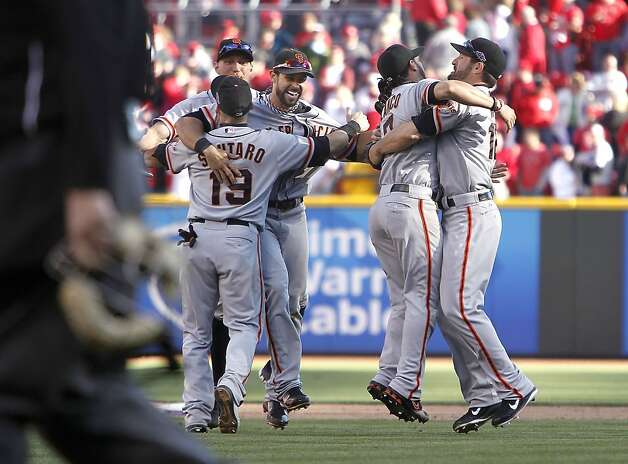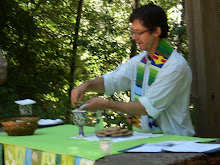On Wednesday morning I watched a few video clips of
election-night victory speeches, and speeches conceding defeat. And the one that really moved me was given by
Tammy Baldwin, the congressional representative from Madison, Wisconsin who
became the first openly-gay person elected to the United States Senate. I have two brothers who live in Madison, and
I called one of them, my younger brother Gareth, to congratulate him on the
historic moment. And he thanked me and
said, “Yeah, it’s really great. But I
have a hard time seeing it from the whole historic-achievement angle. To me Tammy is that lady whose partner used
to be on my softball team.”
I’m reminded of that conversation this morning because the
readings today tell us that while it may be true, as was popularly said in the
1960s and their aftermath, that the personal is political, the reverse is also
true. The political is personal. Take the story of the extraordinary loyalty
and friendship between Naomi, and Ruth, the wife of her deceased son. Naomi and her husband seek refuge in Moab
during a famine in Judah and her sons marry Moabite women. Naomi’s husband dies, and then her sons die,
and Naomi decides to return home, where the famine is ended. She tries to leave her daughters-in-law
behind, but Ruth refuses to stay or to look for another husband among the
Moabites, and so the two of them go together, back to Naomi’s home town of
Bethlehem. The faithfulness of Ruth and
the wiliness of Naomi enable them together to overcome loss and migration and
economic insecurity, and at the end of the story we learn, almost as an
afterthought, that this foreigner Ruth is the grandmother of the greatest of
Israel’s kings.
In the story of Naomi and Ruth we see something of the
vulnerability of widows in a patriarchal society like ancient Israel. If Ruth had not had Naomi to guide her to the
bed of her kinsman Boaz, and if Naomi had not had the youth and beauty of Ruth
as an asset, things might have turned out much worse for them. Indeed, in the Books of Moses “widows and
orphans” appear again and again as a kind of shorthand for the most
economically and socially precarious members of the community. The very heart of the Torah, the very essence
of the righteousness that is the Hebrews special vocation among the nations of
the earth, and the true measure of their holiness that is like the holiness of
their God, is that they care for widows and orphans.
Jesus has this tradition in mind when he walks into Herod the
Great’s vast gold-plated shopping mall of a temple and starts turning over
tables and knocking down chairs, calling it a “den of robbers.” He is not interested in the religious rituals
that are going on in the temple. Its grandiose
architecture doesn’t tell him anything he doesn’t already know about God. This wonder of the ancient world doesn’t fill
him with nationalistic pride in the power of Israel and its place among the
nations. He’s there to meet the people,
to see for himself what is happening to them.
When we catch up with him today he has been three days in the
temple, teaching the crowd, refuting the priests and the scribes, parrying
their verbal attacks, evading their rhetorical traps, exposing their
hypocrisies, and now he is done. He has
shut up all his critics, and now he is making ready to leave the temple for the
last time. And his last stop is at the
treasury. A lot of words have been said
but they really all come down to this--“All of these splendid buildings and ceremonial
pageantry, all of the mountains of donated money and heaps of sacrificed
animals, all of these priests and scribes living large on the name of the God of
Israel, but the only person who really sacrificed, the only person who really
gave everything for that God, was this little old lady. Oh, and by the way, look at how little she
had left to give.”
The Episcopal Church, and the church in general, has been the
site of a bitter struggle in the last few decades, a struggle that has affected
this congregation in a personal way.
Whatever other kind of struggle it has been, theological, moral, or
spiritual, it is also political. The main
flash points have been the personal politics set in motion by the social
movements of the 1960s—questions about women’s rights, and reproductive choice,
and human sexuality. For over a
generation, the church has been consumed with battles over these issues. And it has carried the fight into the public
square, to the point that these battles have come to define the church, and the
Christian faith, in the minds of our people.
But the general
election last week gave a pretty good indication that the United States is
moving on. It’s not that the battles are
over. And it’s not that there aren’t still
real moral dilemmas to hash out, or that electoral might makes right. But it seems clear that for most Americans,
and especially for the younger generations that are our nation’s future, sexual
politics are no longer a compelling issue.
And I think this is also true for the Episcopal Church. It took a generation. There is still work to be done, especially
the hard work of healing the battle-wounds.
Our church still encompasses a diversity of viewpoints on all kinds of political
and moral issues, and that’s a good thing.
But we’re also ready to move on.
We’re starting to pick ourselves up and dust ourselves off and
look around at what’s happened to our churches during the generation we spent
fighting about sex. And while we’re at it,
we’re asking what’s been happening to our neighborhoods? And what’s happening to our schools, and our
jobs? What’s happening to the earth? What’s
happening to the widows and the orphans?
When Father Norm Cram and Betty and Joe Petrillo and some
other folks decided in 2007 to continue the life of St. John’s Episcopal
Church, and to fight to regain the property of this parish, it was a personal
decision, but it was also a political one.
It was a campaign in the church’s long war over sexual politics. But it was more than that. We know and are proud of that story. We always will be. But we also need to move on.
We need to start to put the renewal of St. John’s in the
context of another political decision, one that was also deeply personal. It’s a story that began at the Washington
Hotel in 1856, when a group of people who were engaged in founding a new
community on the banks of the Petaluma River, came together with the Book of
Common Prayer in their hands. They
decided that the public life of this new town should be formed by the public
worship of the Episcopal Church. It’s a
story that continued with the decision, a couple of years later, to purchase
some land on this corner of 5th and C, and to give that public worship
a permanent address, a home in the neighborhood. It’s a story that includes the 1890 decision
to build this building, and the 1940s decision to tear down the old guild hall
over there and the rectory over there and build the building that stands there
now.
Those decisions were political. Underlying each of them was a vision not just
for St. John’s Episcopal Church, but for Petaluma. They were made with a sense for the way our
particular take on the gospel of Jesus Christ forms people for life in
community, and that it is something that needs to be shared. So what is our vision for Petaluma now? What might we contribute to the public life
around us? Well, we might remember the
politics of Jesus, a politics that is personal.
That is to say, it is about human relationships and human needs. It will be about breaking through ideological
divisions and fostering new networks of common interest and mutual
belonging. It begins with simple
questions—“What is going on in our neighborhood? Who lives here? Where do they work? What do they need? Where is new life stirring? What is passing away?” And maybe most important questions are, “How
will we find out?” and “How do I talk to a stranger?”



